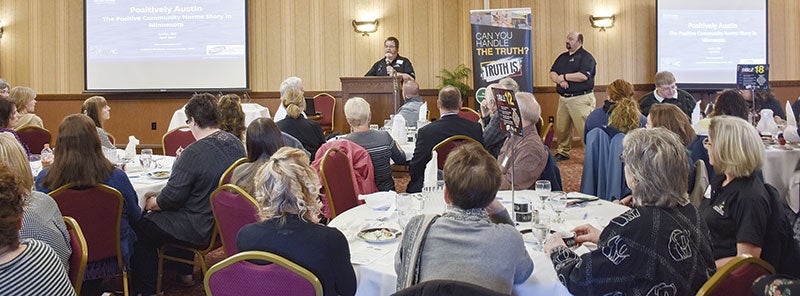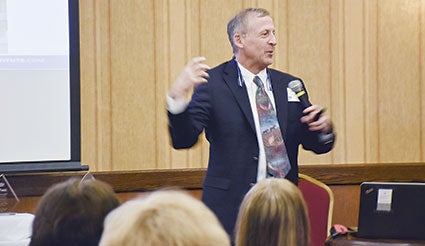The science of the positive
Published 8:14 am Thursday, April 13, 2017

- Mayor Tom Stiehm addresses the crowd at the Hormel Historic Home. Michael Stoll/mike.stoll@austindailyherald.com
When it comes to addressing substance abuse in Austin, a leader in the field says Austin is on the right path in promoting the positives to combat negative misperceptions.
“Perception is everything, and so to is misperception,” said Dr. Jeff Linkenbach of the Montana Institute in Bozeman, Montana.
Linkenbach was the keynote speaker at a dinner hosted at the Hormel Historic Home Tuesday evening by the Austin Positive Action Committee (APAC).
Linkenbach was on hand to discuss the implementation of positive community norms and how they can promote a healthy community.
“If we want health, we must promote health,” he said.

Dr. Jeff Linkenbach talking about positive community norms at the Hormel Historic Home Tuesday night.
Michael Stoll/mike.stoll@austindailyherald.com
Austin is in the first year of APAC, a five-year Planning and Implementation grant aimed at reducing underage tobacco, alcohol and drug use. But to do that, Austin leaders are focusing on alcohol and tobacco use via positive community norms.
“People who use hard drugs like cocaine and heroin did not start with them,” said Austin Planning and Implementation Coordinator Bill Spitzer, who addressed the crowd before Linkenbach spoke. “They started with tobacco and alcohol.”
Linkenbach visited Austin about 10 years ago to promote the concept to specialists from across the state, and it’s been used to form a multimillion dollar partnership and grant through the Minnesota Department of Human Services, which has since been implemented in several communities.
Austin is one of the most recent.
“Positive community norms is a framework where we gather data and present that data back to communities,” Linkenbach said. “At the heart of the work is the fact that we often misperceive the positive norms around us.”
Linkenbach helped pioneer the concept of positive community norms by developing what he calls the “science of the positive.”
“It is a framework for understanding and focusing on the positive in our communities and in our cultures and finding ways to strategically grow the positive,” he said.
Linkenbach gave examples of studies done among middle and high school students concerning perception and reality.
“Young people think there is much more drinking going on amongst their peers than is actually the case,” he said of student survey results. “We can present data back over a period of time through posters and skits and all sorts of interactive activities, and when we flip that misperception around, the behavior and the attitudes seem to follow.”
Linkenbach said the implementation of positive community norms has been successful in reducing underage tobacco use and alcohol consumption.
“In Montana, we saw a 13 percent reduction in drinking and driving in young people across the state,” he said. “In Minnesota, we’ve been doing this work for about 10 years with two different five-year groups and we’ve seen some significant reductions as well in underage drinking in the 10 communities that we would work with at a time.”
APAC will be using the grant to get these facts out to the community. It is part of APAC’s “Truth Is” media campaign.
For more information on Dr. Jeff Linkenbach and positive community norms, visit www.montanainstitute.com.





